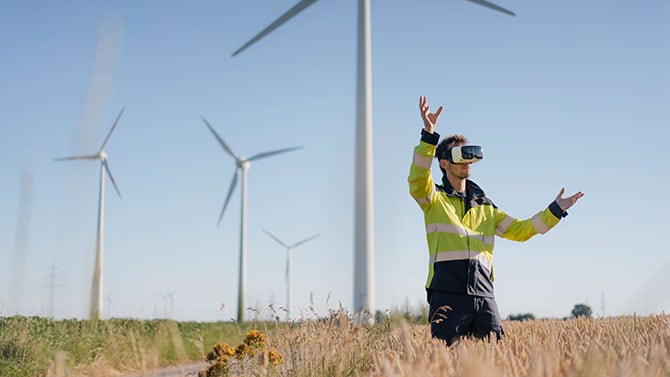
Asking the ‘why’ question in emissions reduction paves the way for transformation
21/02/22
‘Net zero’ in strategy, governance and business transformation
The practical guide 'The building blocks for net zero transformation' describes the main building blocks for businesses on their way to net zero CO2 emissions. Our earlier article about formulating the ambition for emission reduction, is followed by embedding in strategy, convincing governance and the actual business transformation. What is involved in these building blocks of change? Jeroen Crijns of PwC Strategy& talks about the importance of the 'why' question and PwC's Willem-Jan Dubois discusses the 'how' and 'what' of the transformation to 'net zero'.

One and a half degrees of warming
They see the pennies gradually starting to drop everywhere. In recent years, Jeroen Crijns and Willem-Jan Dubois have noticed a sharp increase in their clients' awareness of the need and opportunities for ESG policy and climate action. Take COP26, the United Nations climate conference', last autumn, says Dubois, who leads the ESG team at PwC Consulting. 'The enormous impact of two degrees of warming on our planet, instead of one and a half degrees was well highlighted there. The world community's decision to limit warming to one and a half degrees is, I believe, now understood by an increasingly large group.
"If the organisation's top management knows how it will create value with a zero carbon business model in the long term, it is easier to take the pain involved in the transition."
Need for action is clear
Crijns, who as a strategy consultant mainly works for clients in the financial sector, points to last summer's natural disasters: 'The forest fires and floods that we all saw happening, I think, opened the eyes of many. Whereas until recently I saw a struggle within companies between those in favour and those against integrating climate change into strategy and operations, that debate now seems settled and the momentum has increased enormously. That balance has also been altered by customers, suppliers and investors wanting ESG policies, by staff and new talent asking questions, and by increasingly compelling laws and regulations. In PwC's recently presented 25th CEO Survey, a quarter of Dutch CEOs who took part in the research now say they are aiming for 'net zero'. A third say they are preparing for it.

Willem Jan Dubois
Sustainability as a core topic
In addition to the recognition of climate change and its risks, Crijns also sees a clear change in the place of ESG within organisations. Ten years ago, I saw initiatives at corporates to reduce CO2 for example, but these were side projects of the sustainability manager. Now ESG, including the ambition of 'net zero', is more often embedded in the corporate strategy. Dubois also sees this happening: 'The discussion is shifting from waste separation and electric lease cars to sustainability in the primary process and in the product portfolio. Sustainability is becoming a core topic in thinking about the entire value chain, including outside the organisation's own boundaries.
Why go net zero?
The PwC publication 'The building blocks for net zero transformation' supports companies with practical steps in their emission reduction. Crijns and Dubois notice that this is necessary, as real transformation is not easily done. According to Crijns, the struggle with ESG plans in practice is due to a lack of attention to fundamental thinking: 'Why do we want to become "net zero"? Because the world’s climate needs it and because of the company's right to exist. We want to fulfill that right to exist with a business case that is likely to change significantly, but one that is solid. Companies that answer the 'why' question at the strategic level, understand why transformation is necessary first of all and then encounter fewer problems with the 'how' and 'what' questions.
"The discussion is shifting from waste separation and electric lease cars to sustainability in the primary process and in the product portfolio. Sustainability is becoming a core theme in thinking about the entire value chain, also outside one's own organisation."
A vision from the top makes the difference
In addition to strategic embedding, Crijns mentions the importance of solid governance: 'The "net zero" ambition and the transition that follows from it have the greatest chance of success if the organisation's top management takes responsibility for them. The combination of strategy and governance makes a big difference in a practical sense: 'If the organisation’s leadership knows how it is going to create value with a business model without CO2 emissions in the long term, then it is easier to take the pain associated with the transition.
"Companies that answer the ‘why’ question at the strategic level, understand why transformation is needed first of all, and will then encounter fewer problems with the how and what questions."
Net zero transformation case studies
PwC colleague Karin Meijer previously talked about formulating the ambition for emission reduction with a baseline and targets. Dubois advises clients on answering the 'how' and 'what' questions in the case of transformation. Dubois: 'The insight into one's own performance compared to the targets must be clear. It lays the foundation for the reduction plan, in which the strategy and the concrete transition steps come together. The building blocks for net zero transformation' describes not only key transformation actions, but also case studies in which these actions come to life. For example, in addition to electric cars, Mercedes is also building CO2-neutral production in its own factories and is in close contact with the most CO2-intensive suppliers to identify reduction opportunities.
All business processes and systems
As the Mercedes example, but also those of Danone, Starbucks and other companies in the publication show, the transition can involve all business processes and systems in the value chain, Dubois explains: 'Purchasing and production, financial function and supply chain, they often all require adjustment. If companies want to reduce not only their own emissions and those from purchased heat and energy, but also indirect emissions - scope three of the Greenhouse Gas Protocol - then the entire value chain really needs to be examined. As with any transformation, getting people on board is a prerequisite: 'Making a plan is one thing. We then help to ensure that everyone understands what is intended and that everyone feels involved in carrying out the plan.

Jeroen Crijns
Seizing the opportunities
Why does Dubois feel involved in ESG and net zero? I think it is important to help companies stay relevant in the long term. Mitigating climate risks, among others, is essential in this respect. It is valuable that we can actually contribute to this transformation with our knowledge and experience. Finally, Crijns points out the demand for sustainable products, which has been growing for years: 'There is a clear demand from consumers, who are often also willing to pay a little more. It is up to companies to take an entrepreneurial approach to emission reduction. Use the opportunities in the changing market to balance the business case'.



















